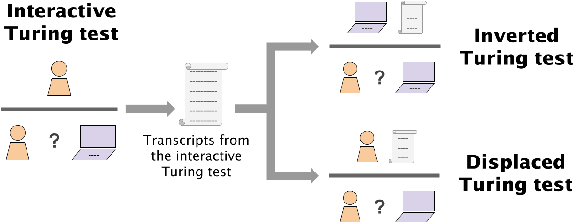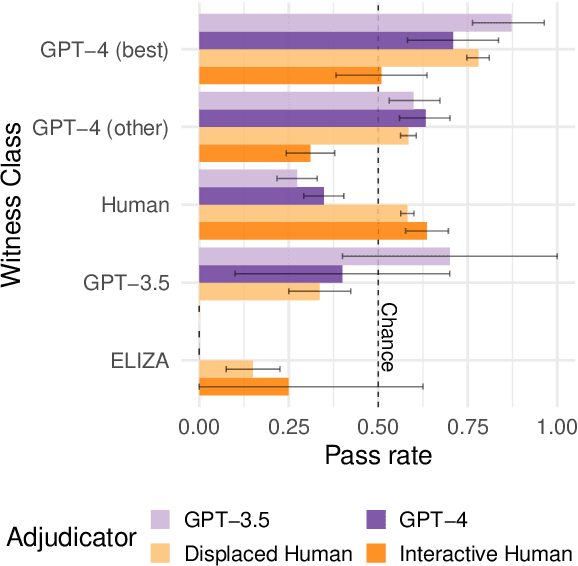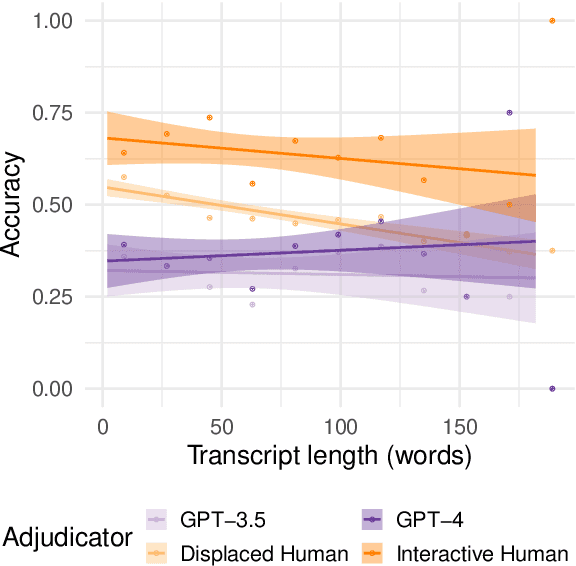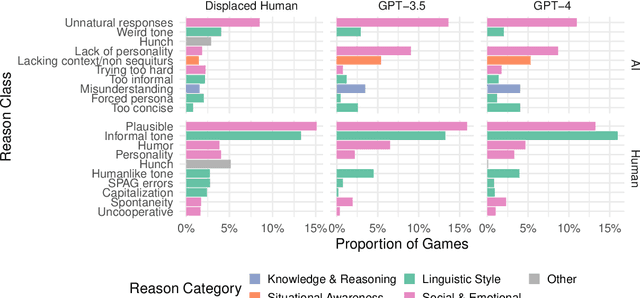Benjamin K. Bergen
Not quite Sherlock Holmes: Language model predictions do not reliably differentiate impossible from improbable events
Jun 07, 2025Abstract:Can language models reliably predict that possible events are more likely than merely improbable ones? By teasing apart possibility, typicality, and contextual relatedness, we show that despite the results of previous work, language models' ability to do this is far from robust. In fact, under certain conditions, all models tested - including Llama 3, Gemma 2, and Mistral NeMo - perform at worse-than-chance level, assigning higher probabilities to impossible sentences such as 'the car was given a parking ticket by the brake' than to merely unlikely sentences such as 'the car was given a parking ticket by the explorer'.
Bigram Subnetworks: Mapping to Next Tokens in Transformer Language Models
Apr 21, 2025Abstract:In Transformer language models, activation vectors transform from current token embeddings to next token predictions as they pass through the model. To isolate a minimal form of this transformation, we identify language model subnetworks that make bigram predictions, naive next token predictions based only on the current token. We find that bigram subnetworks can be found in fully trained language models up to 1B parameters, and these subnetworks are critical for model performance even when they consist of less than 0.2% of model parameters. Bigram subnetworks are concentrated in the first Transformer MLP layer, and they overlap significantly with subnetworks trained to optimally prune a given model. Mechanistically, the bigram subnetworks often recreate a pattern from the full models where the first layer induces a sharp change that aligns activations with next token predictions rather than current token representations. Our results demonstrate that bigram subnetworks comprise a minimal subset of parameters that are both necessary and sufficient for basic next token predictions in language models, and they help drive the transformation from current to next token activations in the residual stream. These subnetworks can lay a foundation for studying language model circuits by building up from a minimal circuit rather than the traditional approach of ablating circuits from a full model.
Large Language Models Pass the Turing Test
Mar 31, 2025Abstract:We evaluated 4 systems (ELIZA, GPT-4o, LLaMa-3.1-405B, and GPT-4.5) in two randomised, controlled, and pre-registered Turing tests on independent populations. Participants had 5 minute conversations simultaneously with another human participant and one of these systems before judging which conversational partner they thought was human. When prompted to adopt a humanlike persona, GPT-4.5 was judged to be the human 73% of the time: significantly more often than interrogators selected the real human participant. LLaMa-3.1, with the same prompt, was judged to be the human 56% of the time -- not significantly more or less often than the humans they were being compared to -- while baseline models (ELIZA and GPT-4o) achieved win rates significantly below chance (23% and 21% respectively). The results constitute the first empirical evidence that any artificial system passes a standard three-party Turing test. The results have implications for debates about what kind of intelligence is exhibited by Large Language Models (LLMs), and the social and economic impacts these systems are likely to have.
Do Large Language Models Exhibit Spontaneous Rational Deception?
Mar 31, 2025Abstract:Large Language Models (LLMs) are effective at deceiving, when prompted to do so. But under what conditions do they deceive spontaneously? Models that demonstrate better performance on reasoning tasks are also better at prompted deception. Do they also increasingly deceive spontaneously in situations where it could be considered rational to do so? This study evaluates spontaneous deception produced by LLMs in a preregistered experimental protocol using tools from signaling theory. A range of proprietary closed-source and open-source LLMs are evaluated using modified 2x2 games (in the style of Prisoner's Dilemma) augmented with a phase in which they can freely communicate to the other agent using unconstrained language. This setup creates an opportunity to deceive, in conditions that vary in how useful deception might be to an agent's rational self-interest. The results indicate that 1) all tested LLMs spontaneously misrepresent their actions in at least some conditions, 2) they are generally more likely to do so in situations in which deception would benefit them, and 3) models exhibiting better reasoning capacity overall tend to deceive at higher rates. Taken together, these results suggest a tradeoff between LLM reasoning capability and honesty. They also provide evidence of reasoning-like behavior in LLMs from a novel experimental configuration. Finally, they reveal certain contextual factors that affect whether LLMs will deceive or not. We discuss consequences for autonomous, human-facing systems driven by LLMs both now and as their reasoning capabilities continue to improve.
On the Acquisition of Shared Grammatical Representations in Bilingual Language Models
Mar 05, 2025Abstract:While crosslingual transfer is crucial to contemporary language models' multilingual capabilities, how it occurs is not well understood. In this paper, we ask what happens to a monolingual language model when it begins to be trained on a second language. Specifically, we train small bilingual models for which we control the amount of data for each language and the order of language exposure. To find evidence of shared multilingual representations, we turn to structural priming, a method used to study grammatical representations in humans. We first replicate previous crosslingual structural priming results and find that after controlling for training data quantity and language exposure, there are asymmetrical effects across language pairs and directions. We argue that this asymmetry may shape hypotheses about human structural priming effects. We also find that structural priming effects are less robust for less similar language pairs, highlighting potential limitations of crosslingual transfer learning and shared representations for typologically diverse languages.
Lies, Damned Lies, and Distributional Language Statistics: Persuasion and Deception with Large Language Models
Dec 22, 2024Abstract:Large Language Models (LLMs) can generate content that is as persuasive as human-written text and appear capable of selectively producing deceptive outputs. These capabilities raise concerns about potential misuse and unintended consequences as these systems become more widely deployed. This review synthesizes recent empirical work examining LLMs' capacity and proclivity for persuasion and deception, analyzes theoretical risks that could arise from these capabilities, and evaluates proposed mitigations. While current persuasive effects are relatively small, various mechanisms could increase their impact, including fine-tuning, multimodality, and social factors. We outline key open questions for future research, including how persuasive AI systems might become, whether truth enjoys an inherent advantage over falsehoods, and how effective different mitigation strategies may be in practice.
Why do language models perform worse for morphologically complex languages?
Nov 21, 2024Abstract:Language models perform differently across languages. It has been previously suggested that morphological typology may explain some of this variability (Cotterell et al., 2018). We replicate previous analyses and find additional new evidence for a performance gap between agglutinative and fusional languages, where fusional languages, such as English, tend to have better language modeling performance than morphologically more complex languages like Turkish. We then propose and test three possible causes for this performance gap: morphological alignment of tokenizers, tokenization quality, and disparities in dataset sizes and measurement. To test the morphological alignment hypothesis, we present MorphScore, a tokenizer evaluation metric, and supporting datasets for 22 languages. We find some evidence that tokenization quality explains the performance gap, but none for the role of morphological alignment. Instead we find that the performance gap is most reduced when training datasets are of equivalent size across language types, but only when scaled according to the so-called "byte-premium" -- the different encoding efficiencies of different languages and orthographies. These results suggest that no language is harder or easier for a language model to learn on the basis of its morphological typology. Differences in performance can be attributed to disparities in dataset size. These results bear on ongoing efforts to improve performance for low-performing and under-resourced languages.
Goldfish: Monolingual Language Models for 350 Languages
Aug 19, 2024Abstract:For many low-resource languages, the only available language models are large multilingual models trained on many languages simultaneously. However, using FLORES perplexity as a metric, we find that these models perform worse than bigrams for many languages (e.g. 24% of languages in XGLM 4.5B; 43% in BLOOM 7.1B). To facilitate research that focuses on low-resource languages, we pre-train and release Goldfish, a suite of monolingual autoregressive Transformer language models up to 125M parameters for 350 languages. The Goldfish reach lower FLORES perplexities than BLOOM, XGLM, and MaLA-500 on 98 of 204 FLORES languages, despite each Goldfish model being over 10x smaller. However, the Goldfish significantly underperform larger multilingual models on reasoning benchmarks, suggesting that for low-resource languages, multilinguality primarily improves general reasoning abilities rather than basic text generation. We release models trained on 5MB (350 languages), 10MB (288 languages), 100MB (166 languages), and 1GB (83 languages) of text data where available. The Goldfish models are available as baselines, fine-tuning sources, or augmentations to existing models in low-resource NLP research, and they are further useful for crosslinguistic studies requiring maximally comparable models across languages.
GPT-4 is judged more human than humans in displaced and inverted Turing tests
Jul 11, 2024



Abstract:Everyday AI detection requires differentiating between people and AI in informal, online conversations. In many cases, people will not interact directly with AI systems but instead read conversations between AI systems and other people. We measured how well people and large language models can discriminate using two modified versions of the Turing test: inverted and displaced. GPT-3.5, GPT-4, and displaced human adjudicators judged whether an agent was human or AI on the basis of a Turing test transcript. We found that both AI and displaced human judges were less accurate than interactive interrogators, with below chance accuracy overall. Moreover, all three judged the best-performing GPT-4 witness to be human more often than human witnesses. This suggests that both humans and current LLMs struggle to distinguish between the two when they are not actively interrogating the person, underscoring an urgent need for more accurate tools to detect AI in conversations.
Dissecting the Ullman Variations with a SCALPEL: Why do LLMs fail at Trivial Alterations to the False Belief Task?
Jun 20, 2024

Abstract:Recent empirical results have sparked a debate about whether or not Large Language Models (LLMs) are capable of Theory of Mind (ToM). While some have found LLMs to be successful on ToM evaluations such as the False Belief task (Kosinski, 2023), others have argued that LLMs solve these tasks by exploiting spurious correlations -- not representing beliefs -- since they fail on trivial alterations to these tasks (Ullman, 2023). In this paper, we introduce SCALPEL: a technique to generate targeted modifications for False Belief tasks to test different specific hypotheses about why LLMs fail. We find that modifications which make explicit common inferences -- such as that looking at a transparent object implies recognizing its contents -- preserve LLMs' performance. This suggests that LLMs' failures on modified ToM tasks could result from a lack of more general commonsense reasoning, rather than a failure to represent mental states. We argue that SCALPEL could be helpful for explaining LLM successes and failures in other cases.
 Add to Chrome
Add to Chrome Add to Firefox
Add to Firefox Add to Edge
Add to Edge